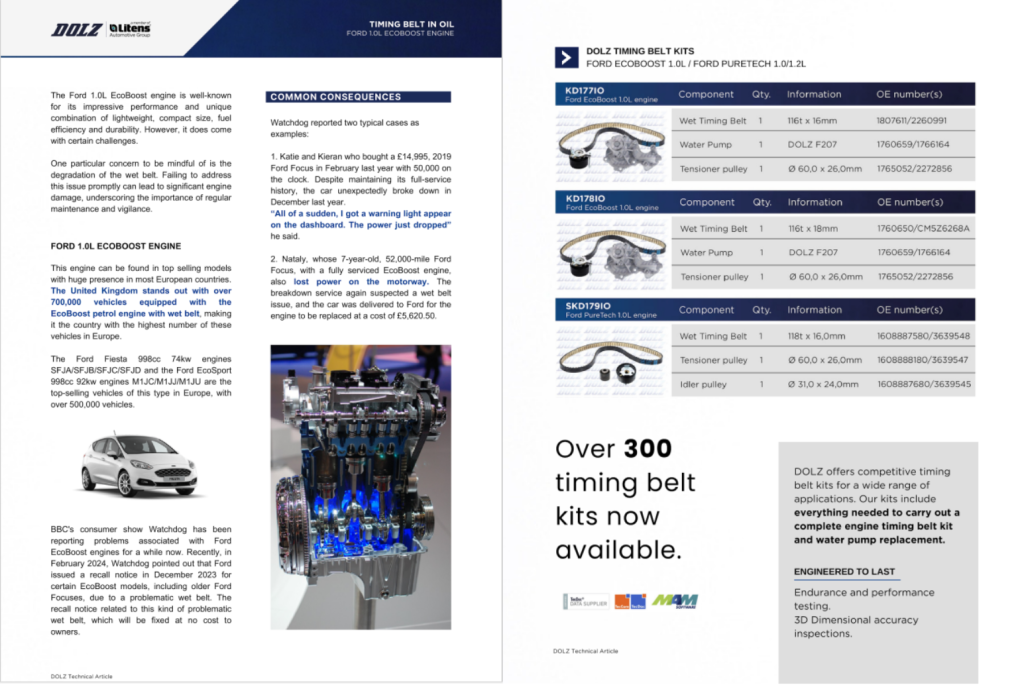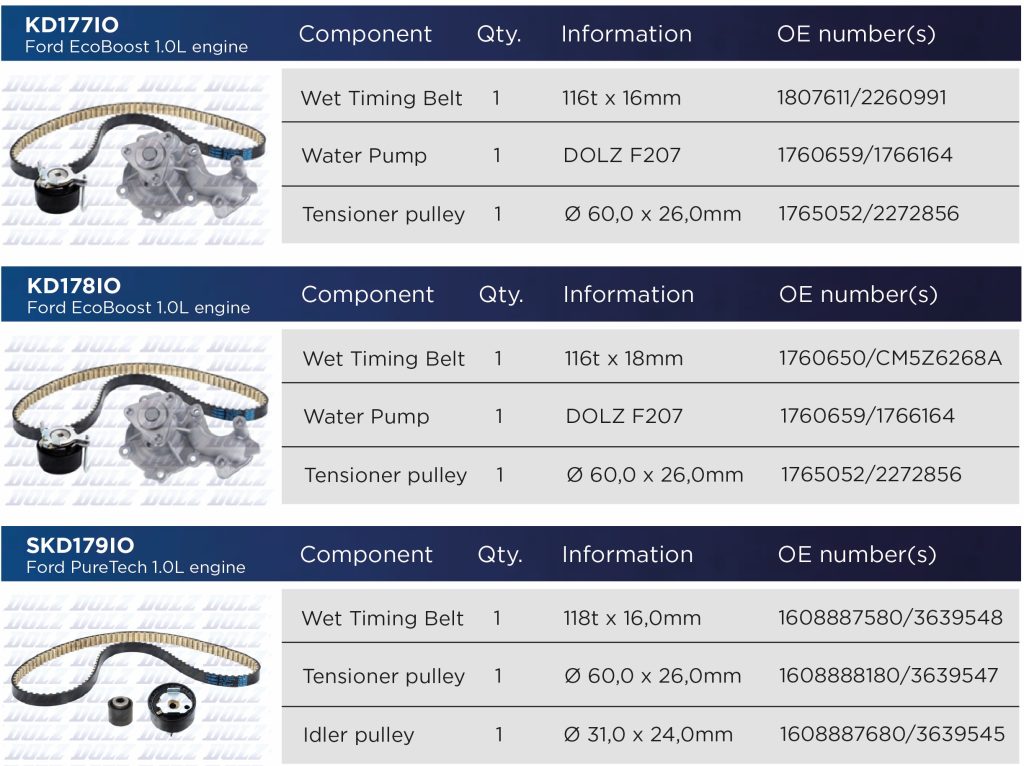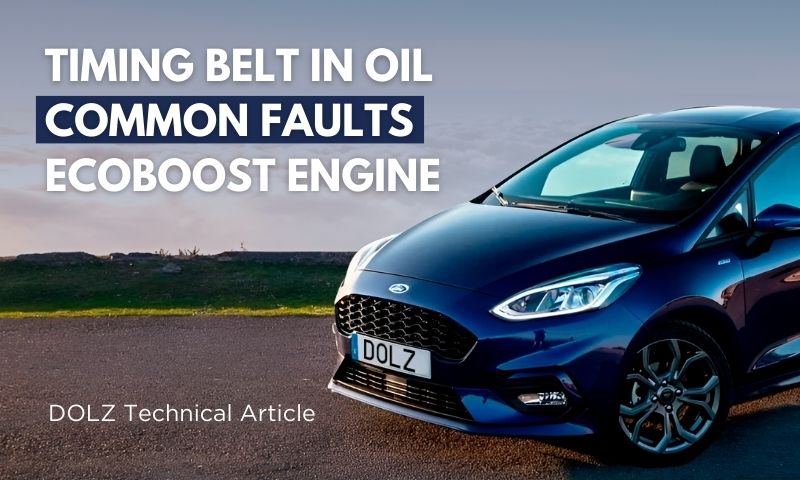The Ford 1.0L EcoBoost engine is well-known for its impressive performance and unique combination of lightweight, compact size, fuel efficiency and durability. However, it does come with certain challenges. One particular concern to be mindful of is the degradation of the wet timing belt. Failing to address this issue promptly can lead to significant engine damage, underscoring the importance of regular maintenance and vigilance.
Ford 1.0L EcoBoost Engine
This engine can be found in top selling models with huge presence in most European countries. The United Kingdom stands out with over 700,000 vehicles equipped with the EcoBoost petrol engine with wet belt, making it the country with the highest number of these vehicles in Europe.
The Ford Fiesta 998cc 74kw engines SFJA/SFJB/SFJC/SFJD and the Ford EcoSport 998cc 92kw engines M1JC/M1JJ/M1JU are the top-selling vehicles of this type in Europe, with over 500,000 vehicles.
The BBC’s consumer show Watchdog has been reporting problems associated with Ford EcoBoost engines for a while now. Recently, in February 2024, Watchdog pointed out that Ford issued a recall notice in December 2023 for certain EcoBoost models, including older Ford Focuses, due to a problematic wet belt. The recall notice related to this kind of problematic wet belt, which will be fixed at no cost to owners.

Download Dolz Tech Article 1.0 EcoBoost or Keep reading
Common consequences of a wet belt issue
Watchdog reported two typical cases as examples:
- Katie and Kieran who bought a £14,995, 2019 Ford Focus in February last year with 50,000 on the clock. Despite maintaining its full-service history, the car unexpectedly broke down in December last year.
“All of a sudden, I got a warning light appear on the dashboard. The power just dropped” he said. - Nataly, whose 7-year-old, 52,000-mile Ford Focus, with a fully serviced EcoBoost engine, also lost power on the motorway. The breakdown service again suspected a wet belt issue, and the car was delivered to Ford for the engine to be replaced at a cost of £5,620.50.
Problem Assessment
The issue at hand has been extensively researched and not only affects to the Ford EcoBoost 1.0L. It extends to all engines that have implemented the wet timing belt system, such as those found in PSA’s PureTech engines.
The introduction of the wet belt in the timing system dates back to 2007. One of its key advantages over a conventional belt system is the significant reduction in friction between the timing belt teeth and the pulley gears. This is due to the fact that oil has a lower friction coefficient than rubber, resulting in less wear and improved performance. Achieving 2.5% less fuel consumption compared to a standard timing system.
Traditionally, oil and belts have been seen as an incompatible pair. However, in this case, it’s not exactly like that. Wet timing belts are specifically designed to achieve a good behavior and performance when the contact with engine oils. The problem is not the oil, the real issue lies in the petrol!
Now, let’s dive into the specific explanations:
When examining the piston head diameter, it’s important to note that a slight variation of 0.4 mm can occur between temperatures of 20ºC and 200ºC.
What does it mean?
This variance indicates that when the vehicle is still cold, there is a potential for petrol to seep over the piston heads into the lubricating system and can lead to a small amount of petrol mixing with the oil.
So, in this point is where issues arise with wet belts, as their behavior when in contact with petrol is less than ideal. Over time, these belts start to degrade, especially on the outer surface, as we can see in the following pictures:
Oil pumps, as we know, play a crucial role in the engine’s performance by continuously circulating oil from the sump pan to vital engine components. So, in this point, the particles from the degraded belt can mix with the oil and flow into the engine.
The problems at this moment are:
- Timing belt particles degraded due to the constant contact with oil and petrol mix act as debris within the system, accumulating at the end of the sump pan. Eventually, these particles are drawn into the pick-up pipe, blocking the entrance, and leading to a loss of engine pressure and inadequate lubrication, with the corresponding catastrophic consequences.
- Degradation of the timing belt can ultimately lead to timing belt breakdown resulting in potential engine damage due to the misalignment between the valves and head piston movement.
What has made OE to solve the problem?
Apart of the recall in the USA and the cost-sharing initiative in Europe, OE manufacturers have taken the proactive step of reducing the timing belt replacement interval.
Specifically, for the Ford Fiesta EcoBoost mentioned earlier in this article, it was originally recommended to change the timing kit at 150,000 miles. However, a precautionary measure was later advised for a replacement at 100,000 miles.
Expert Advice: Dolz’s recommendations to avoid major problems with timing belt in oil
In addition to following Ford’s recommendation of using 05W20 oil and changing the timing belt every 12,000 miles, Industrias Dolz recommends taking extra care by regularly checking the carter and inspecting the wet belt and oil pump inlet every two oil changes. It is crucial to address any belt degradation promptly by cleaning the oil pump inlet and replacing the timing kit to ensure optimal performance and longevity of your vehicle.
Neglecting to replace the wet belt as recommended could lead to significant consequences for your engine, especially if the vehicle is predominantly used for short trips or driven infrequently.
Why choose DOLZ timing belt kits?
Dolz offers two timing kits, KD177IO and KD178IO, specifically designed for Ford 1.0L EcoBoost engines. And the reference SKD179IO for Ford PureTech 1.0/1.2L engines.
The Dolz wet belts are designed to last, with innovative cutting-edge materials, high robustness, and proven reliability. That’s why the latest wet belt design features a reinforced compound with a PTFE white layer on the teeth fabric, providing enhanced resistance to potential diesel fuel contamination in the oil:
- Resistance insert (E-glass/ K-glass/ Hybrid).
- Compound body (HNBR, fiber loaded).
- Tooth covering fabric (Nylon HT, Ny+Ar, full Aramid) + PTFE skin.

DOLZ, a member of Litens Automotive Group, offers competitive timing belt kits for a wide range of applications. Our kits include everything needed to carry out a complete engine timing belt kit and water pump replacement.
Make sure to subscribe to our monthly newsletter to read more posts like this!

